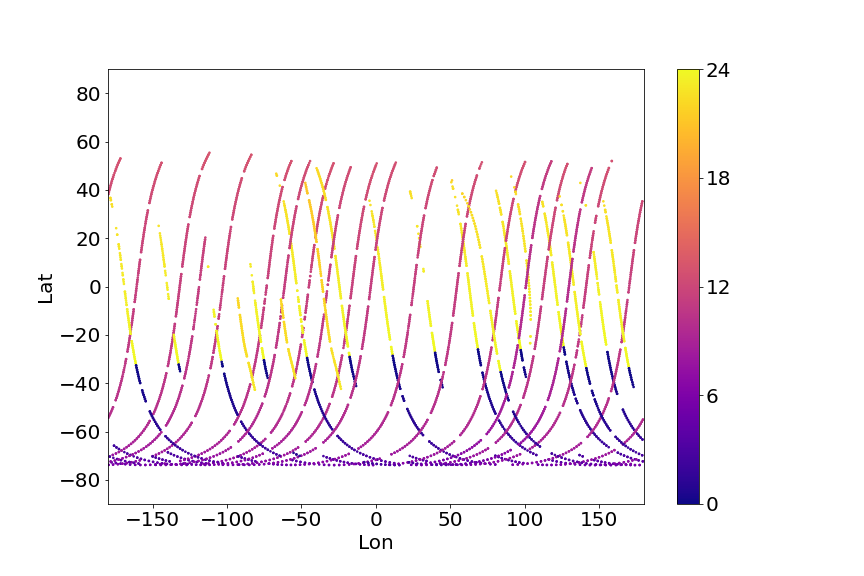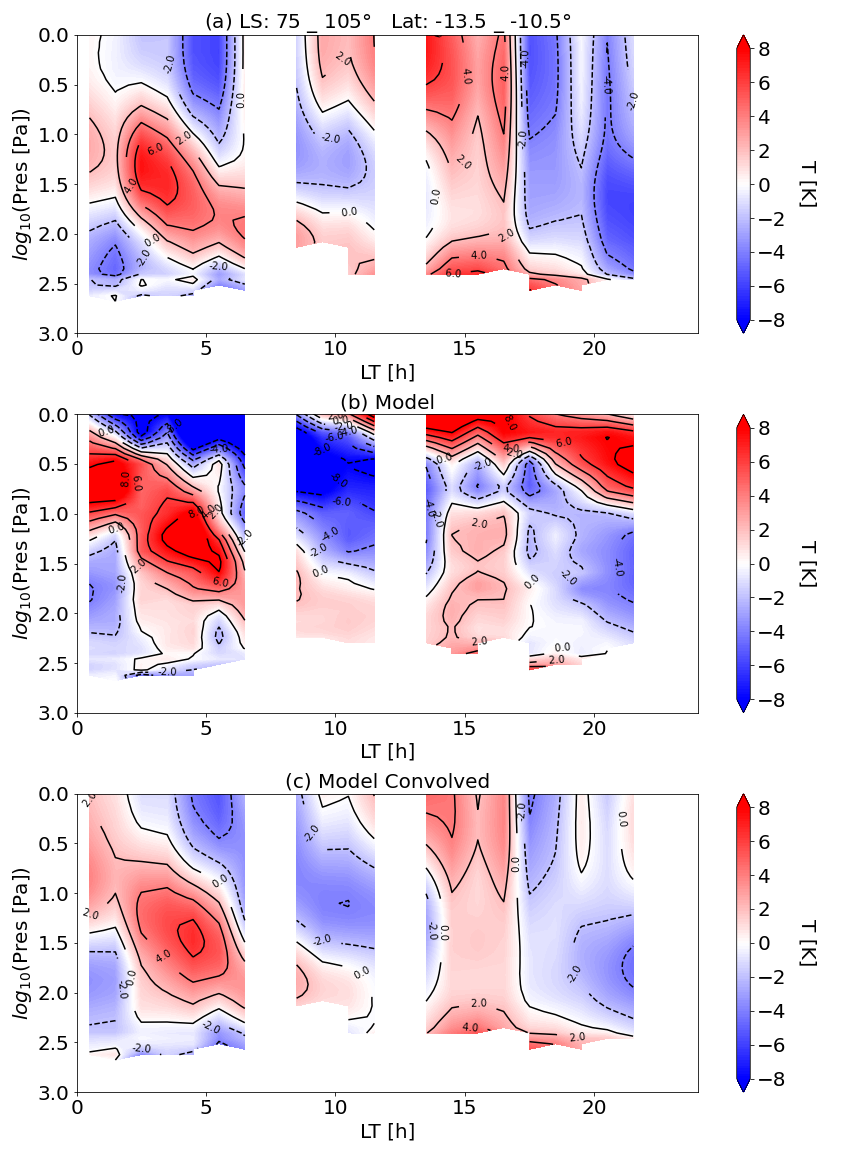Thermal tides in Martian atmosphere from ACS/TIRVIM
- 1LMD/IPSL, Sorbonne Université, PSL Research University, École Normale Supérieure, École Polytechnique, CNRS, Paris, France (sfan@lmd.ipsl.fr)
- 2Space Research Institute (IKI), Moscow, Russia
- 3LATMOS/IPSL, Guyancourt, France
Thermal tides in Martian atmosphere from ACS/TIRVIM
Siteng Fan1 (sfan@lmd.ipsl.fr), Sandrine Guerlet1, Francois Forget1, Antoine Bierjon1, Ehouarn Millour1, Nikolay Ignatiev2, Alexey Shakun2, Alexey Grigoriev2, Alexander Trokhimovskiy2, Franck Montmessin3, Oleg Korablev2
1: LMD/IPSL, Sorbonne Université, PSL Research University, École Normale Supérieure, École Polytechnique, CNRS, Paris, France
2: Space Research Institute (IKI), Moscow, Russia
3: LATMOS/IPSL, Guyancourt, France
Abstract
Atmospheric thermal tides are planetary-scale temperature oscillations driven by diurnal solar forcing. On Mars, they dominate the temperature variations and winds throughout the thin atmosphere due to its low heat capacity. Given the short timescales of tide modes, which are typically equal or shorter than a Martian day, analyses of these tides require observations with large spatial coverage and high local time resolution. Observations from the TIRVIM Fourier-spectrometer, part of the Atmospheric Chemistry Suite (ACS) onboard ExoMars Trace Gas Orbiter (TGO), provide data meeting such requirement. Here we report the spatial- and temporal-dependent temperature profiles of Martian atmosphere retrieved from TIRVIM nadir data. Amplitudes and phases of thermal tide modes are obtained, and their influence on the thermal structure of Martian atmosphere is estimated using numerical simulations, The LMD Mars Global Circulation Model (GCM).
Introduction
Diurnal thermal forcing by solar radiation excites temperature oscillations in Martian atmosphere through direct sunlight absorption and heat exchange with Mars surface (Gierasch & Goody 1968). Influenced by surface topography, the varying solar forcing produces harmonic responses in the Martian atmosphere, thermal tides (Zurek 1976). Some modes of the tides can vertically propagate to upper altitudes with amplitudes growing exponentially with decreasing air density, which therefore influences the atmospheric circulation. The existence of such temperature and the related pressure variations has been observed by many Mars landers and orbiters (e.g., Hess et al., 1977, Banfield et al. 2000, Lee et al. 2009, Kleinböhl et al. 2013, Forbes et al. 2020), but observations are still lacking for comprehensive studies as large spatial coverage and high temporal resolution are required to study such planetary-scale diurnal/sub-diurnal variations.
Methodology and Results
We analyze the thermal tides using temperature structures retrieved from TIRVIM nadir data. TIRVIM is a thermal infrared Fourier-spectrometer, as part of the ACS instrument onboard the ESA-Roscosmos mission ExoMars TGO (Korablev et al., 2018, Svedhem et al. 2020). TGO is on a non-solar-synchronous orbit with a period of 2 hours, so observations obtained at nadir viewing geometry could cover a wide range of local time due to the short orbital period and orbit drifting (Capderou & Forget, 2004, Figure 1). A full diurnal cycle can be sampled between 74°N and 74°S within ~55 solar days (sols), which is equivalent to ~30° in solar longitude (Ls). Binning data within this range results in data covering most local time in a specific Martian month with little seasonal variations. TIRVIM operated from April 2018 to December 2019, nearly one Martian year (MY) from MY34 Ls134° to MY35 Ls 115°, and provides ~1.5 million thermal infrared nadir-viewing spectra with decent data quality. Despite some degeneracy, we retrieved temperature profiles together with dust and water ice from these spectra (Guerlet et al. 2018). Each profile covers a vertical range from ~2-3km above Mars surface to ~50-55km (~1-2Pa) with a vertical resolution of ~1 scale height (10km). Full coverage of local time is obtained for the first time on sub-seasonal scales (Figure 1), which makes it possible to evaluate thermal tides in Martian atmosphere with details and resolve the harmonic aliasing introduced by solar-synchronous observations, e.g., observations at 3am and 3pm local time by the Mars Climate Sounder (MCS, Lee et al. 2009).
A preliminary result of the thermal structure on the Martian southern hemisphere near MY35 spring equinox (Ls=90°) is shown in Figure 2a. We binned the data between Ls 75° to 105° so that most of the local time is covered. No dust storms are identified during this period. The selected bin size of latitude is 3° and that of the local time is 1 hour. Temperature profiles are also zonal averages, so only migrating tides are shown. The diurnal temperature difference structure shows diurnal and semi-diurnal cycles at lower and middle atmosphere, respectively, with “apparent” amplitudes of ~7K. Due to the degeneracy introduced by vertically distributed sensitivity response functions of TIRVIM thermal infrared spectra, the retrieved temperature profiles are vertically smoothed (Guerlet et al. 2018). Suggested by the LMD Mars GCM (Forget et al. 1999), amplitudes of these tides are 2-3 times larger (Figure 2b), as smoothing them with the same response functions gives similar diurnal temperature difference structure (Figure 2c). A priori in the temperature profile retrieval makes a difference in extracting the diurnal temperature anomaly at low pressure level due to small weights in the convolution kernels (Figure 2b and 2c), which requires further investigation with GCMs.

Figure 1. Spatial-temporal coverage of ACS/TIRVIM observations. Data from 20 orbits are shown for the purpose of illustration, with colors denoting the local time.

Figure 2. (a) Diurnal temperature anomaly derived using ACS/TIRVIM observations. The data is binned between MY35 Ls 75° and 105°, and between 10.5°S and 13.5°S in latitude. (b) Result of the LMD Mars GCM. The model result has the same spatial-temporal sampling weight as observations. (c) Same as (b), but vertically convolved with the averaging kernels of TIRVIM.
References
Banfield, D., Conrath, B., Pearl, J. C., et al. (2000). JGR, 105, 9521.
Capderou, M., & Forget, F. (2004). P&SS, 52, 789.
Forbes, J. M., Zhang, X., Forget, F., et al. (2020). JGR: Space Physics, 125, e28140.
Forget, F., Hourdin, F., Fournier, R., et al. (1999). JGR, 104, 24155.
Gierasch, P., & Goody, R. (1968). P&SS, 16, 615.
Guerlet, S., Ignatiev, N., Fouchet, T., et al. (2018). EPSC, 2018-223.
Hess, S. L., Henry, R. M., Leovy, C. B., et al. (1977). JGR, 82, 4559.
KleinböHl, A., John Wilson, R., Kass, D., et al. (2013). GRL, 40, 1952.
Korablev, O., Montmessin, F., Trokhimovskiy, A., et al. (2018). SSW, 214, 7.
Lee, C., Lawson, W. G., Richardson, M. I., et al. (2009). JGR: Planets, 114, E03005.
Svedhem, H., Korablev, O., Mitrofanov, I., et al. (2020). EPSC, 2020-802.
Zurek, R. W. (1976). JAS, 33, 321.
How to cite: Fan, S., Guerlet, S., Forget, F., Bierjon, A., Millour, E., Ignatiev, N., Shakun, A., Grigoriev, A., Trokhimovskiy, A., Montmessin, F., and Korablev, O.: Thermal tides in Martian atmosphere from ACS/TIRVIM, Europlanet Science Congress 2021, online, 13–24 Sep 2021, EPSC2021-183, https://doi.org/10.5194/epsc2021-183, 2021.

